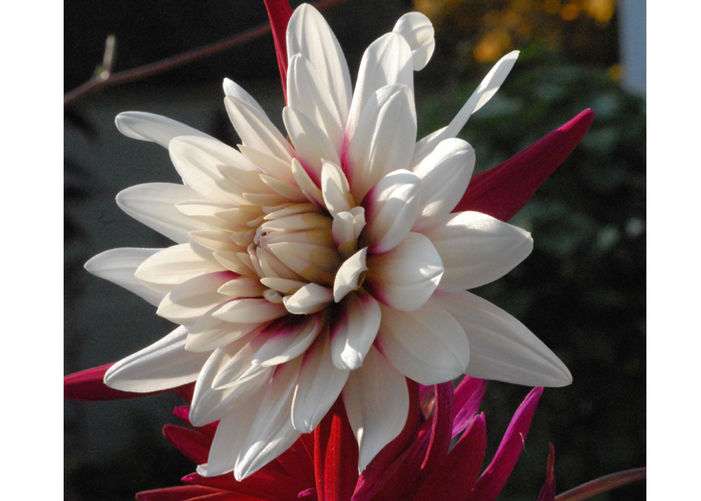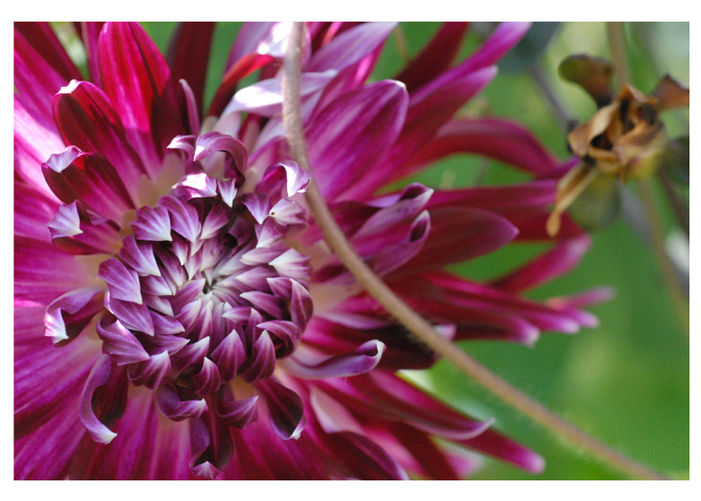DAHLIAS ON PARADE SLIDESHOW
by Tovah Martin
Bulbs aren’t meant to be displayed by onesies, you need numbers to make an impact. One lone tulip just doesn’t do it, and I figured that the same was true for dahlias. So, I decided to do them up BIG. That meant clustering a whole lot of dahlia containers together (just like my furniture, I went for a mismatched pastiche) on the back porch. It also entailed tucking lots of dahlia tubers into the garden. In the end, I got the Baboom! celebration of big, beefy, colorful flowers that I was aiming for on the back patio. In the garden, I got some attrition due to a vole epidemic—but some dahlias managed to escape the subterranean gluttons-in-residence.
THE CONCEPT:As we all know—whoever has the most dahlias wins. And they fill a niche in summer when everything else is pretty much exhausted (except the rudbeckias). So I figured that I’d give the back patio a surge of color by clustering a grouping of dahlias planted in ornamental large, beautiful terra cotta pots. It worked like a charm. Simultaneously, I also put some dahlias in the garden—the idea was to bolster up the boring time. Since I love flowers, dahlias seemed like the perfect enlistees for the job. THE CHALLENGE:
Although this was a slow summer here and many flowers came in late, the dahlias in pots were everything I hoped for. Whereas some friends had trouble pushing their dahlias along in the garden, mine blossomed beautifully in my porch containers. But alas, things didn’t go quite so swimmingly in the garden. This was the summer from hell as far as voles were concerned. We reached epidemic proportions and they chewed roots that they don’t normally pester—including the dahlias.

Planted in early June, buried with their crowns 1-2 inches below the soil surface in containers that were 12 inches and larger, the dahlias came up with lightning speed to fill their containers. From the very beginning, they looked great. And by the end of the season, even the most gigantic pots were dense with roots.

Because dahlia roots are so dense and fill a large pot fully, I usually don’t try to mix them with companions in the same container. Also, I prefer to use an organic potting mix with compost included to give these hungry plants a Breakfast of Champions.

Even the smaller growing, dark-leaved, single-flowering types like ‘HS Date’ and ‘HS Romeo’ fill in a pot rapidly. Plus, the foliage is part of the show before the flower buds begin to develop.

By July, the first dahlias were opening, beginning with ‘Karma Naomi’. When a dahlia unfolds its petals, the drama goes on for a day or more. The wind-up is part of the show.

Each flower on ‘Karma Naomi’ was 3 inches wide or more, with petals that reminded me of an Elizabethan ruff. The color was such a deep burgundy, it was difficult to capture the hue with a camera, especially in the sun (and dahlias crave sun to flower properly).

Fortunately, I had plenty of opportunity to focus on ‘Karma Naomi’ because the plants kept pumping out blossoms. Everyone who visited my garden asked its identity.

The dahlia that won the diversity award was definitely ‘Rebecca’s World’. Each 3-4 inch blossom was different—like snowflakes. And the contrast between the blood red and snow white petals was astonishingly gorgeous.

It’s hard to find a royal purple flower in midsummer when the perennials are in a lull, so that’s why ‘Thomas Edison’ was invaluable. Rather than the insipid mauve that is the hue of most so-called purple flowers, ‘Thomas Edison’ makes a strong color statement.

My personal favorite was Dahlia ‘Akita’ – I loved the quill-like petals reminiscent of a Native American headdress. And talk about prolific—‘Akita’ was continually forming buds and flowers that lingered long.

See what I mean about a Native American headdress? Each petal has so many nuances in color from tip to center.

I bought the ‘Akita’ blend and each bulb varied in color—by planting several bulbs together in a container, I got the full pageant of shades.

Like most dahlias, the buds on ‘Akita’ nod before they open, but when they unfurl, they face up or outward. Although very tightly closed buds might not open when cut, if they show color, they’ll usually continue to unfold in a vase.

I grew one large container of ‘Akita’ bulbs beside the fence to my vegetable garden, with morning glories behind and these great companions blossomed simultaneously.

The huge surprise in the ‘Akita’ blend was the garnet-colored flowers that opened from some of the bulbs. Together with the orange version, they were like a summer sky at sunset.

Yes, the morning glories had to be “disciplined” to keep them from strangling the dahlia stems, but ‘Akita’ stood its own ground.

Meanwhile, some of the dahlias that I planted in the garden managed to survive the vole plague to come into blossom. One of my favorite combinations was the single, peach-colored Dahlia Mignon ‘HS Date’ beside Coreopsis verticillata ‘Route 66’. Both the dahlia and the coreopsis tend to weave their stems, making for a great marriage.

Another strong survivor in the border was Dahlia ‘HS Romeo’ with its cherry red, single flowers produced in quantity. Unlike the taller dahlias, ‘HS Romeo’ stood only a foot to 20 inches tall and the dark foliage contrasted the bright flowers.

I planted ‘HS Romeo’ beside Heuchera villosa ‘Brownies’ and the dahlia’s nearly black leaves played off the dark foliage of the heuchera to make for a meaningful dialog between the plants.

One of the traits of ‘HS Romeo’ that I particularly valued was its luminous quality in the shadows later in the day. In late September, when this photo was taken, the days are beginning to shorten, but the red flowers made a sharp statement late in the afternoon. Next year, I’ll try new vole tactics to safeguard the dahlias from those greedy nibblers.



